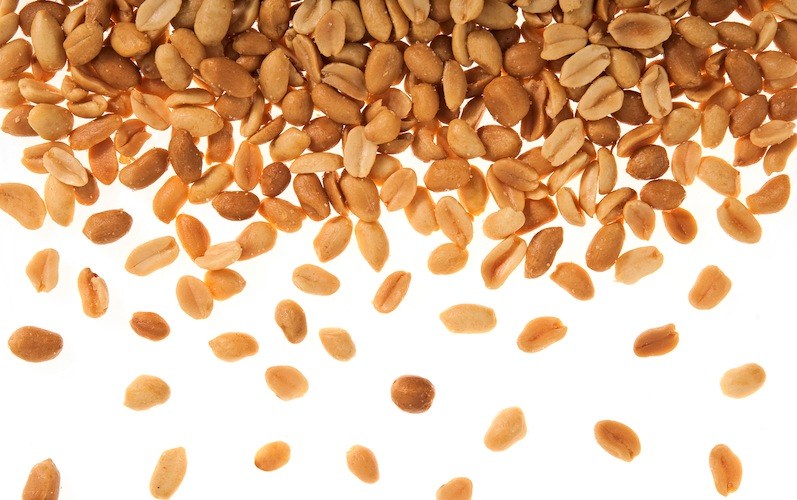20-week treatment makes life safer for kids with peanut allergy

A study last week in The New England Journal of Medicine suggests that exposing infants to peanuts can provide lasting protection against peanut allergy. But what about peanut-allergic children right now? They and their parents live a life of precautions — from pre-screening birthday party menus to segregation at the school lunch table — to avoid life-threatening consumption of even trace amounts of peanut.
Now, a multicenter study reports on a protocol combining the allergy medication omalizumab (Xolair) with controlled, gradually increasing peanut consumption. After 20 weeks, most initially allergic children could safely consume the equivalent of 8 to 10 peanuts at a time. Three months after stopping the medication, most had worked up to 16 to 20 peanuts.
This might not seem like much, but it’s incredibly liberating for kids with peanut allergy, who tend to have more severe reactions than those with milk or egg allergy and usually remain allergic for a lifetime.
“Patients can react to even small amounts of peanut in foods, and often avoid many processed foods because of labeling indicating possible peanut contamination,” says Andrew MacGinnitie, MD, PhD, clinical director of the Division of Allergy and Immunology at Boston Children’s Hospital, which led the study. “The need for constant vigilance can negatively impact quality of life.”
PRROTECT-ing kids from peanut reactions
Doctors have tried desensitizing children by gradually exposing them to peanuts, but this approach alone can cause severe reactions, particularly with rapid increases in peanut doses. The double-blind PRROTECT study, reported this week at the American Academy of Allergy, Asthma & Immunology meeting, added Xolair into the mix. The results validate the two-pronged approach for the first time in a controlled trial.
Extending a pilot study published in 2013, MacGinnitie, co-leader Rima Rachid, MD, and colleagues randomized 37 peanut-allergic children to begin treatment with either Xolair (29 children) or placebo (eight children) for 12 weeks. The medication was injected subcutaneously every two or four weeks depending on the child’s weight and level of IgE, the antibody that causes allergy.
Then:
- At week 12, the children underwent a single-day challenge, consuming escalating doses of peanut protein over six hours (spaced 30 minutes apart) as tolerated, under supervision. Twenty-three of the 27 Xolair-treated children still enrolled in the study were able to weather the highest dose (250 mg, the equivalent of one peanut), versus just 1 of 8 children given placebo. The kids then kept taking their maximum tolerated dose at home for one week; if they had no reactions, their peanut dose was increased weekly for eight weeks.
- At week 20, 21 Xolair-treated children and 1 of 8 placebo-treated children could safely consume 2,000 mg (eight to 10 peanuts). Drug (or placebo) treatment was then stopped.
- At week 26, 23 of the 27 Xolair-treated children (85 percent) could still safely consume eight to 10 peanuts, versus 1 of 8 of those given placebo (12.5 percent).
- At week 32, 12 weeks after stopping medication, came the biggest challenge: 4,000 mg or 16 to 20 peanuts. Twenty-two of 27 children who had received Xolair passed the challenge, versus 1 of 8 placebo-treated children.
“This study has proven that patients can be desensitized to higher peanut doses at a faster rate than conventional oral immunotherapy,” says Rachid. “However, the optimal duration of combined therapy remains to be further evaluated. Also, omalizumab is given by injections and is very expensive, so it should be determined which patients would benefit best from adding it to oral immunotherapy.”
Learn more about the Food Allergy Program at Boston Children’s Hospital.
Related Posts :
-

A toast to BRD4: How acidity changes the immune response
It started with wine. Or more precisely, a conversation about it. "My colleagues and I were talking about how some ...
-

AI-designed proteins open doors to new immunotherapies
Artificial intelligence (AI) is increasingly helping drive advances in science and medicine — including cellular signaling. In a recent study, published ...
-

An unbreakable bond: Brothers turn medical complexities into superpowers
“Look! Is that one JetBlue? I think that one’s Delta!” Running through the grass, climbing on the jungle gym, ...
-

Team spirit: How working with an allergy psychologist got Amber back to cheering
A bubbly high schooler with lots of friends and a passion for competitive cheerleading: On the surface, Amber’s life ...





